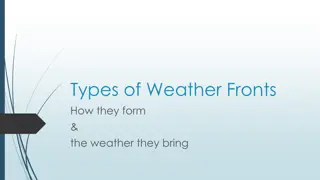Understanding Gas Laws in Weather Phenomena
Exploring the behavior of gases in weather-related scenarios, such as the ascent of helium-filled weather balloons, by applying the combined gas law to analyze the relationships among pressure, volume, and temperature. The discussion delves into the impact of changing variables on gas properties, emphasizing how pressure influences gas volume at varying altitudes.
Download Presentation

Please find below an Image/Link to download the presentation.
The content on the website is provided AS IS for your information and personal use only. It may not be sold, licensed, or shared on other websites without obtaining consent from the author. Download presentation by click this link. If you encounter any issues during the download, it is possible that the publisher has removed the file from their server.
E N D
Presentation Transcript
Living By Chemistry SECOND EDITION Unit 3: WEATHER Phase Changes and Behavior of Gases
Lesson 61: What Goes Up Combined Gas Law
ChemCatalyst A weather balloon is inflated with helium to a volume of 125,000 L. When it is released, it rises high into the atmosphere, where both the pressure and the temperature are lower. 1. Explain why the balloon rises. 2. Will the balloon pop at a high altitude? Explain your thinking.
Key Question What is the relationship among pressure, volume, and temperature for a sample of gas?
You will be able to: define the combined gas law solve gas law problems that involve changes in all three of the variables, P, V, and T
Prepare for the Activity Work in pairs.
Discussion Notes The relationship among the pressure, temperature, and volume of a gas is described by the combined gas law. Combined Gas Law P2V2 T2 P1V1 T1 K = PV T or =
Discussion Notes (cont.) Temperature ( C) Temperature (K) Pressure (atm) Volume (L) Altitude 40,000 ft 216 K 0.20 atm 47,000 L 57 C 30,000 ft 228 K 0.30 atm 33,000 L 45 C 25,000 ft 238 K 0.40 atm 26,000 L 35 C 10,000 ft 268 K 0.70 atm 17,000 L 5 C 5,000 ft 278 K 0.80 atm 15,000 L 5 C 0 ft 290 K 1.0 atm 12,500 L 17 C
Discussion Notes (cont.) The weather balloon rises no matter what the outside conditions because the balloon is full of helium, and helium is less dense than air.
Wrap Up What is the relationship among pressure, volume, and temperature for a sample of gas? If volume, temperature, and pressure all vary, then you can use the combined gas law to determine the effects of changing two variables on the third. (Amount of gas remains the same.) k = PV T Air temperature and air pressure both decrease with increases in altitude. Ultimately, for a weather balloon, gas pressure has a greater effect on gas volume than does gas temperature.
Check-In A sample of neon gas occupies a volume of 1.0 L at 300 K and 1.0 atm. 1. Calculate the value of the proportionality constant, k. 2. Suppose you increase the temperature to 600 K and decrease the pressure to 0.50 atm. Does the volume of the gas increase or decrease? Explain your answer.























